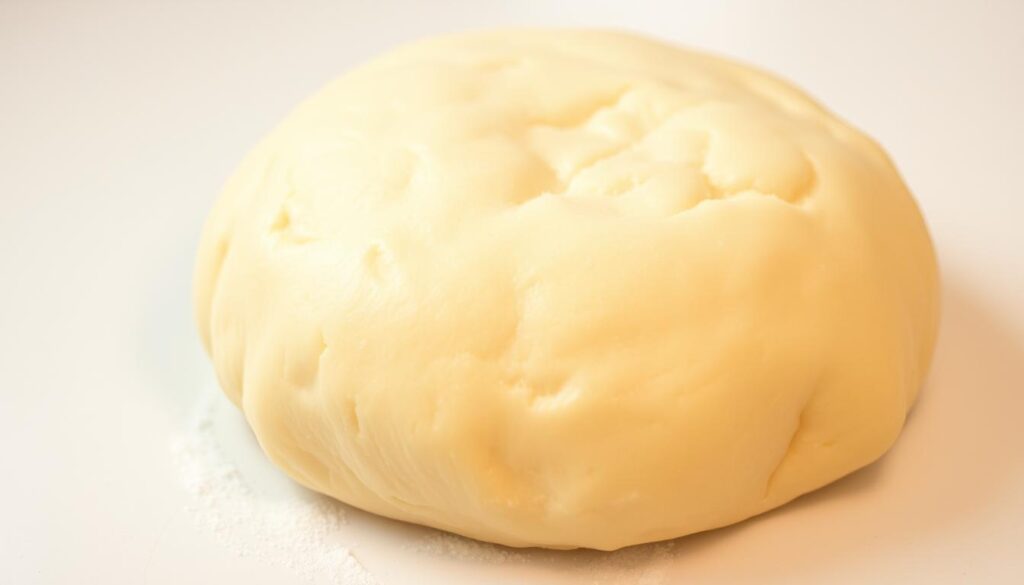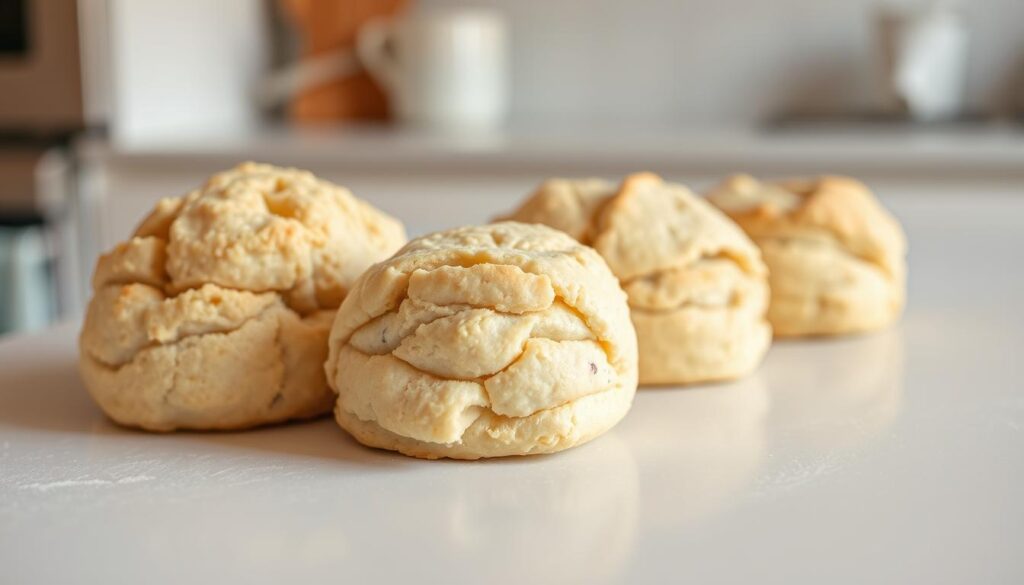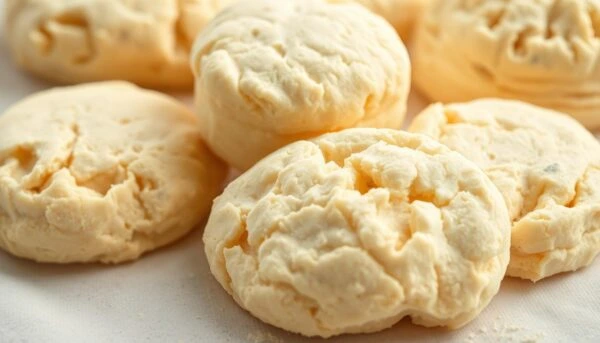Remember the smell of fresh biscuits in your childhood kitchen? It was like a warm hug, inviting you to enjoy the flaky goodness. Biscuit dough types are key to this experience, each one offering its own special traits and tastes. From the tender short dough to the buttery sweet dough, knowing these types can make your baking better.
This knowledge is vital for both home bakers and commercial biscuit makers. It ensures quality and texture in every batch. As we dive into biscuit dough, you’ll learn how to use these unique qualities. This way, every batch you make becomes a special memory waiting to happen.
Table of Contents
The Importance of Biscuit Dough in Baking
Biscuit dough is the base for tasty baked goods. Knowing how dough affects texture and flavor is key to making great biscuits. The ingredients and their amounts greatly impact your biscuit’s final taste and texture. making it essential to understand their differences and uses. Link to a scientific baking guide: Understanding Baking Science.
Role of Dough in Texture and Flavor
The dough’s makeup is crucial for the biscuit’s texture. Different fats can make biscuits soft or crispy. Soft biscuits have 16-31% fat, while hard ones have 9-21%.
Adding the right leavening agents like baking powder makes biscuits light and airy. This makes the biscuit experience better.
Choosing ingredients wisely also affects flavor. Sugar helps with texture and adds color. You can add cheese, herbs, or dried fruits for unique tastes.
Efficiency in Biscuit Machines
Baking efficiently is vital in kitchens. Biscuit machines help by mixing and shaping dough consistently. This ensures every biscuit is of the same quality.
Using quality ingredients like grass-fed butter improves flavor. It’s important to handle the dough gently to keep it tender and flaky.
Understanding Biscuit Dough Types
Baking biscuits requires knowing the different dough types. Each type has its own purpose, giving bakers the chance to be creative. By understanding biscuit dough, you can pick the right one for your biscuits. Curious about how dough variations can affect recipes? Check out Biscuit Dough vs. Dumplings to explore the fascinating differences in dough applications.
Differentiating between Dough Varieties
There are several dough types used in biscuit making. Each has its own special qualities. Here are the main types:
- Short Dough: It’s crumbly and has a lot of fat, making biscuits rich and tender.
- Sweet Dough: With more sugar, it’s sweeter, perfect for dessert biscuits.
- Rich Dough: It has more fat, making biscuits moist and is great for fancy recipes.
- Choux Dough: Known for making light pastries, it puffs up, creating airy biscuits.
- Whole Grain Dough: Made with whole grain flour, it’s healthier and has a nutty taste.
Each dough needs specific ingredients and methods. Knowing this helps you make biscuits just the way you like them.
Short Dough
Short dough is loved by many bakers for its rich taste and soft texture. It’s perfect for making different baked goods. This dough has a lot of fat, which is key to its crumbly texture.
It’s made with flour, sugar, and lots of butter or margarine. This mix helps keep the dough from becoming tough. As a result, the biscuits turn out beautifully short.
Characteristics and Composition
The ingredients in short dough make it special. It usually has:
- Flour
- Butter or margarine
- Sugar
- Occasionally, flavoring agents like vanilla
The butter adds a lot of flavor, making the cookies melt in your mouth. Unlike other doughs, short dough doesn’t have eggs. This keeps it dry. It’s important to handle it gently and chill it before baking.
Popular Biscuit Types made from Short Dough
Short dough is used to make many favorite biscuits. You might know:
- Shortbread: A classic choice known for its crumbly, melt-in-your-mouth texture.
- Butter cookies: These buttery cookies are a favorite during holidays and celebrations.
- Tea biscuits: Light and delicate, perfect for afternoon tea.
These biscuit types show how versatile short dough is. The right mix of fat and flour makes them rich in flavor and tender.
Sweet Dough
Sweet dough is a key part of baking, known for its versatility and taste. It’s made with sugar and flavorings like vanilla. This makes baked goods even more enjoyable.
The unique flavors of sweet dough make it popular in many recipes. It’s especially loved in sugar cookies and sweet pastries.
Flavor Profiles of Sweet Dough
The sweetness of sweet dough comes from sugar, butter, and flavorings. This mix creates a variety of tasty profiles. You might taste vanilla, lemon, or spices, adding to the sweetness.
This makes it perfect for improving the taste of baked treats.
Common Uses in Biscuit Recipes
Sweet dough is essential in many biscuit recipes. It’s great for making classic sugar cookies, loved for their softness and sweetness. It’s also perfect for fruit-filled pastries, where it holds fillings beautifully.
Its ability to be shaped into intricate designs lets bakers get creative. This results in stunning baked goods.

Rich Dough
Rich dough is special in baking because of its mix of ingredients. It has more fat and sugar, plus eggs and dairy. This makes baked goods tender, moist, and full of buttery flavor.
Texture and Flavor Contributions
The dough’s texture is soft because of the fat. It doesn’t form gluten like leaner doughs. The mix of butter, sugars, and other ingredients adds depth to pastries.
Items like croissants and danishes are perfect for showing off this dough. They offer a delightful taste experience.
Baking Applications for Rich Dough
Rich dough is used in many baking tasks. It’s great for making layered pastries, like puff pastry. The dough’s fat content helps it rise and stay flaky.
It’s important to mix and bake carefully. This ensures the dough doesn’t spread too much. Following these steps is key to getting the best results.
Choux Dough
Choux dough, also known as pâte à choux, is famous for its light and airy texture. It has been around since the 16th century, thanks to Catherine de’Medici. The dough gets its name from « cabbage » because it looks like a puffed cabbage after baking.
Its high moisture content allows it to expand a lot. This makes it perfect for creating hollow pastries that are loved in many cuisines.
Unique Properties and Uses
This dough is great for making cream puffs, éclairs, and churros. The recipe includes water, milk, butter, flour, eggs, and sugar. The type of liquid used can change the dough’s color and puffiness.
Using all water makes the dough puffier but paler. More milk gives it a richer color but less lift. The right flour adds strength to keep the dough’s shape while it expands.
Creating Hollow Pastries
To make hollow pastries, you need the right baking technique. Start by baking at 415°F to create steam. This steam helps the dough rise.
After the initial bake, lower the temperature to cook evenly and get a crispy outside. Using a serrated tip helps prevent the dough from cracking. Small holes in the base let steam out, keeping the shape right.
Remember, baking times vary. Smaller puffs take about 20 minutes, while bigger éclairs need more time to bake properly and stay crispy inside.
Whole Grain Dough
Whole grain dough is packed with nutrients and is super versatile in baking. It lets you make tasty, healthy biscuits that everyone will enjoy. The dough’s texture and nutty taste are perfect for many recipes.
Health Benefits of Whole Grain Dough
Whole grain dough is great for you because it’s full of fiber, vitamins, and minerals. Flours like amaranth and quinoa are especially nutritious. Amaranth flour has all nine essential amino acids and lots of iron, magnesium, and phosphorus. Quinoa flour is a complete protein and rich in potassium. Adding these to your baking makes your biscuits healthier.
Popular Whole Grain Biscuit Variations
- Whole Wheat Blueberry Muffins: Low in calories and full of flavor, great for breakfast.
- Honey Whole Wheat Pan Rolls: Light rolls that go well with any meal.
- Whole Grain Banana Pancakes: A tasty way to start your day with bananas’ sweetness.
- Almond Berry Pancakes: Tastes like almonds and berries, a healthy treat.
These variations show off the unique taste and texture of whole grain dough. They’re both yummy and good for you.
| Biscuit Variation | Calories per Serving | Protein (g) | Fiber (g) |
|---|---|---|---|
| Whole Wheat Blueberry Muffins | 158 | 3 | 1 |
| Honey Whole Wheat Pan Rolls | 114 | 2 | 1 |
| Whole Grain Banana Pancakes | 186 | 7 | 3 |
| Almond Berry Pancakes | 239 | 7 | 3 |
| Hearty Multigrain Pancakes | 243 | 9 | 3 |
Trying out whole grain dough can lead to amazing results. You’ll get nutritious and tasty biscuits that your family will love.
Biscuit Dough Types: A Closer Look
Understanding the different biscuit types is key to baking success. Each dough type has its own qualities that affect flavor, texture, and look. Choosing the right dough ensures your biscuits turn out delicious.
Different doughs are suited for various uses. Learning about them can make your baking better.
For recipes requiring fluffy textures, you might enjoy exploring Fluffy Chicken Dumplings, which showcase soft dough’s versatility.
Choosing the Right Dough for the Right Biscuit
The right dough makes all the difference. Short dough gives flaky biscuits, while sweet dough is great for cookies. Rich doughs are perfect for indulgent biscuits.
Knowing which dough to use helps achieve the desired biscuit. A classic biscuit recipe is a good starting point. It includes flour, baking powder, and butter.
| Ingredient | Quantity |
|---|---|
| All-Purpose Flour | 2 cups |
| Baking Powder | 1 tablespoon |
| Salt | 1 teaspoon |
| Unsalted Butter | ½ cup (1 stick) |
| Buttermilk | 1 cup |
This recipe is quick to prepare and bakes in 15 minutes. It makes 9 to 12 biscuits, each with about 203 kcal. Baking at 450°F for 10 to 15 minutes gives them a golden look.

Processing Techniques for Biscuit Dough
Getting the biscuit dough right is key to a great biscuit. Every step, from mixing to fermentation, needs careful attention. Knowing how to handle the dough and control temperatures is crucial. The time dough ferments can change its taste and texture a lot. Link to a biscuit recipe resource: Bisquick Chicken Dumplings
Handling and Mixing Guidelines
Mixing biscuit dough needs a specific approach for the best results. Start with slow mixing to spread ingredients evenly. Then, mix at a moderate pace to blend them well. Finish with slow mixing to soak in liquids.
Temperature control is also very important. Keeping the dough cool helps fats solidify. This keeps your biscuits’ texture just right.
Role of Temperature in Dough Quality
Temperature is vital in making biscuits. It affects how the dough ferments and its quality. The right temperature and humidity are needed for the dough to expand and feel right.
Using automation helps keep temperatures steady. This reduces mistakes in biscuit making. By mastering these techniques, you can make better biscuits.
Conclusion: Choosing the Right Dough
Whether you’re crafting a light and fluffy biscuit or a crisp, decorative treat, the choice of dough is crucial. Understanding the differences between the two main biscuit dough types helps you achieve the perfect result for every occasion.
For more ideas and tips, dive into the world of biscuits with inspiration from recipes like Bisquick Chicken Dumplings and Fluffy Chicken Dumplings. Happy baking!

